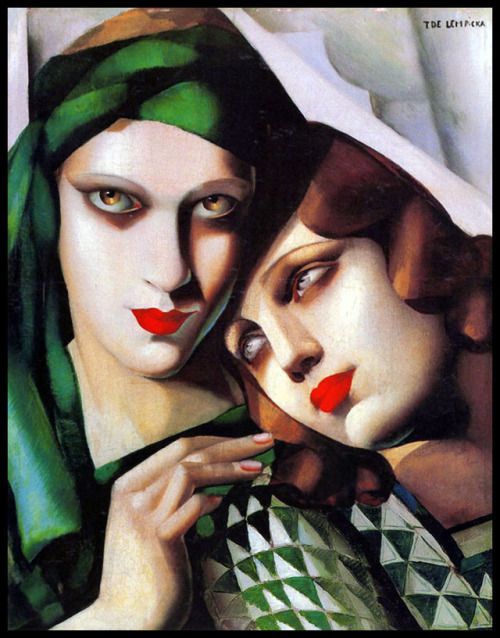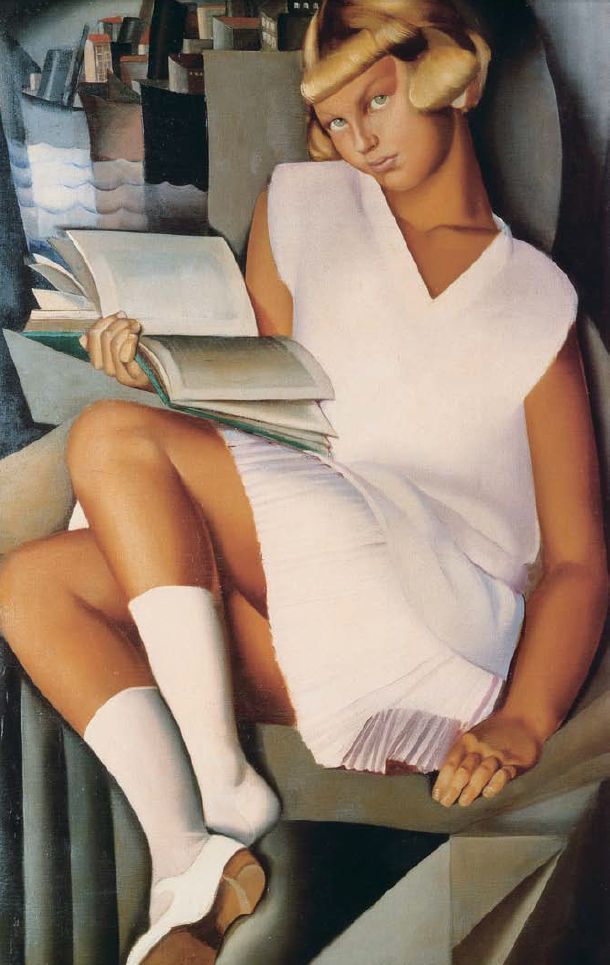
The smoothly metallic portraits, nudes and still lifes of Tamara de Lempicka encapsulate the spirit of Art Deco and the Jazz Age, and reflect the elegant and hedonistic life-style of a wealthy, glamorous and privileged elite in Paris between the two World Wars.

Have you ever heard of a Polish artist named Tamara Gurwik-Gorska ? If so, you’re either a rare bird or Polish / French. Lempicka’s origin and her early life is shrouded in mystery. Our knowledge of her background is dependent upon some highly unreliable fragments of autobiography, and upon the accounts given by her daughter to de Lempicka’s American biographer Charles Phillips. De Lempicka was a fabulist and a self mythologiser of the first order, capable of deceiving her daughter and even herself. Much of her story as told by her daughter has the ring of a romantic novel or a movie script and may not be much more authentic.
Early Life

According to some, de Lempicka changed her birth place from Moscow to Warsaw. There has been speculation that de Lempicka was of Jewish origin on her father’s side and that the deception over her place of birth resulted from an attempt to cover this up.
However, she seems to have identified with the ruling classes of the Tzarist regime that oppressed Poland. It is telling that in 1918 when she escaped from Bolshevist Russia she chose exile in Paris along with thousands of Russian aristocrats, rather than live in the newly liberated and independent Poland.
The Artist
The family of her mother was wealthy enough to spend the “season” in St. Petersburg and to travel to fashionable spas throughout Europe. From what Tamara herself later said, she seems to have enjoyed a happy childhood .The wilfulness of her temperament, apparent from an early age, was indulged rather than tamed. As the story goes, her mother commissioned a portrait of Tamara at the age of twelve turned into an important and revelatory event. It was a torture for the young Tamara to sit for the painting and what was worst that she hated it. This made Tamara to learn the techniques of painting. If Tamara’s vocation was born from this incident as she suggests, she later persuaded her family to send her to Italy.
Visits to museums in Venice, Florence and Rome lead to a life long passion for Italian Renaissance art that informed de Lempicka’s finest work in the 1920s and 30s.

By the time her marriage took place in the chapel in 1916, Romanov Russia was on the verge of collapse under the onslaught of the German army and on the point of being engulfed in revolution. Tamara’s escaped from Russia under a false passport to be re-united with relatives in Copenhagen. Later they moved to Paris.
Paris in the inter-war period was teeming with Russian refugees. It was jokingly said that every second taxi driver in Paris was either a real or pretend Grand Duke.
De Lempicka’s early years in Paris were not happy. According to her own account it was out of this grim situation and a desire for financial and personal independence that de Lempicka’s artistic vocation was born. At the insistence of her sister, Tamara bought the brushes and paints, enrolled in an art school, sold her first pictures within months and made her first million (francs) by the time she was twenty-eight.
Art Deco
The name Art Deco derives from a contraction of the French exhibition title Exposition des Arts Decoratives , though it was not coined until many years later and did not come into common usage until the publication of Bevis Hillier’s book Art Deco of the twenties and thirties in 1968. As a stylistic term invented for architecture and the decorative arts, it may be questioned whether it is appropriate to apply it to painting.

The “intense modernity” and “chilliness” of de Lempicka were both expressed through a devotion to the mechanical and the metallic that are characteristic of the period. One of the most distinctive aspects of de Lempicka’s art is the way she paints everything from human flesh to permed hair and crumpled drapery with metallic sheen.


One of the most iconic images of the Jazz Age and perhaps de Lempicka’s most frequently reproduced picture is the self-portrait at the wheel of an open-topped Bugatti sports car in de Lempicka’s favourite “poison green”, commissioned by the German Fashion magazine Die Dame in 1925. The tight driver’s helmet that masks her permed blond hair and makes her look more like an aviator than a motorist, and her cool impervious stare characterise her as a thoroughly independent and self-confident modern woman. Like the sewing machine and the type-writer in the previous generation (that provided employment however humble inside and outside the home), the motor car contributed significantly to the emancipation of women, if only those at the upper end of the economic scale.
Throughout the Art Deco period de Lempicka showed her allegiance to the machine aesthetic by signing her pictures in printed letters that look like industrial typeface in contrast to the flowing calligraphy favoured by the more painterly artists.
Amongst the value systems that had been thrown into question by the unparalleled catastrophe of the First World War were traditional concepts of gender. The 1920s Paris was the heroic age of Lesbianism. De Lempicka dismissed Gertrude Stein and Ernest Hemingway as
“boring people who wanted to be what they were not. He wanted to be a woman and she wanted to be a man.”
De Lempicka was never reticent about her sexual interest in her own sex. Like Georgia O’Keeffe, de Lempicka seems to have been fascinated by the suggestive form of the flowers and painted arum lilies on several occasions.

De Lempicka painted several canvases of passively and voluptuously posed groups of female nudes that recall the very male view of harem fantasy pictures by nineteenth century artists such as Ingres and Gérôme.
Perhaps the most disturbing paintings by de Lempicka to modern viewers are the portraits she made of young girls including those of her daughter Kizette. Once again these evoke the gaze of the male voyeur rather than that of a woman and a mother in the way they fixate on the young girl’s legs and the often suggestive shadows between them. Kizette in Pink aged barely eight or nine, eyes up the viewer with a gaze as knowing as that of Tamara herself in the photo taken of her in Monte Carlo in 1911.
Influence

Film seems to have played an inordinately important role in both the life and the art of de Lempicka. The immense popularity of de Lempicka’s work, starting in the 1970s, was fuelled by nostalgia for the movies of the inter-war period. If the women she painted often had the eye-rolling allure of silent film stars, the style of the paintings also reminded people of the gleaming, streamlined sets of musicals and screwball comedies. There is no doubt that de Lempicka herself was profoundly influenced by the burgeoning art form of the cinema.
The ubiquity of movies began to influence the way people looked and behaved. De Lempicka’s female subjects with their heavy makeup, perfectly coiffed hair and their theatrical poses and facial expressions full of artificial pathos could have stepped out of the silver screen.
De Lempicka herself with her striking beauty gave herself the airs of a film star. In the late 20s and early 30s, de Lempicka repeatedly had herself photographed in images similar to the stills of glamorous stars issued by the film studio publicity departments, using the same techniques of soft focus and dramatic chiaroscuro and the essential accessories of clunky Art Deco jewellery, casually draped furs and the elegantly wielded cigarette.
On March 18 1980, after months of infirmity and nursed by her daughter as she had demanded, Tamara de Lempicka died.
How good was Tamara de Lempicka as an artist?
She does not offer the profundity of Rembrandt, the truthfulness of Velazquez or the directness and spontaneity of Frans Hals. She is an artists, more interested in beauty than truth.It is true that there is nothing especially original or ground breaking about her art and that she borrowed freely from others. One is reminded of Picasso’s famous dictum that
“Only bad artists borrow. Good artists steal.”
Judged according to this rule, de Lempicka is a very good artist indeed. What she takes she makes her own. Her borrowings are synthesised into a style that is utterly individual and immediately recognisable if all too easily imitated.
In her Art Deco period de Lempicka painted to a formula that looks temptingly easy to reproduce. As anyone who has visited the Paris flea markets in recent years will know, de Lempicka has become one of the mostly widely faked and imitated artists of the twentieth century. There is nothing like imitation and over familiarity to spoil an artist’s reputation and de Lempicka has suffered from both.
In the end de Lempicka’s greatest achievement was that she had something to say about a certain class, at a certain time, in a certain place that no one else was able to say quite as memorably.
Disclaimer: All recommendations are impartial and based on user experience, with no bias to the products or the brand. The products in this post may contain affiliate links.
[…] Have You Heard of Tamara de Lempicka? […]
[…] NOW Tamara de Lempicka Revisited: Her 6 Best Masterworks Have You Heard of Tamara de Lempicka? Hemingway’s 10 Best Quotes: Inspiration. Craft. Influence. And love Quoting Lewis […]